Once we hit November and we’ve gotten through Halloween, Daylight Savings Time, and the first frost, it’s officially the holiday season – and for nonprofits, that means it’s also time for year-end giving campaigns.
Nonprofits receive 50% of their annual donations between October and December. Why is year-end giving such a big deal? The reason is twofold: first, it makes sense to align with the holidays, a time of generosity and giving back. It’s marketable, it’s ripe for good storytelling, and can ease the process of coming up with a fresh campaign concept.
Second, year-end giving gives nonprofits an opportunity to use a big chunk of their resources to meet their annual fundraising goals, and it gives donors a last chance to get a tax-deductible gift out the door.
Not only that, but with the move to more and more online giving, events like GivingTuesday have become an even more important part of your fundraising calendar.
At CauseVox, we’re all about helping everyone meet their goals – donors and the causes they support. We want to help nonprofits that implement year-end fundraising campaigns be successful.
This guide will help you to outline and develop a year-end fundraising campaign that works for your organization and your donors, specifically curated to your needs in 2024.
Creating a Plan for Year-End Giving 2024
As you prepare for the year-end giving season, it’s essential to reflect on past campaigns to guide future success. Many organizations have seen significant growth by setting clear, intentional goals and integrating key moments like GivingTuesday into their year-end strategies.
Your fundraising goals should be aligned with your organization’s needs and informed by a review of your annual projections. Consider these questions when setting your goals:
- Is there a specific project that needs funding before the year’s end or early next year?
- Will the funds be used in the near future or for long-term initiatives?
- Are you raising money for specific programs, operations, or both?
- What is a realistic financial target given your timeline and community support?
- Would a monetary goal or a goal based on impact metrics be more motivating?
- Will there be matching gifts or major donor support to boost your campaign?
- What changes or needs do you anticipate in the upcoming year?
Your answers to these questions should help you to determine the type of campaign you want to create, and how you do it. A year-end campaign with a goal of $5,000 is much different than one set at $100,000. Urgently-needed funds will also make a difference in your messaging and timeline as opposed to funds that can be used in a year or two.
Ideally, you’ll want to have your plans in process during August and September, with October as your final prep time. One strategy that has proven successful for many organizations is securing matching gifts from board members or donors. Matching campaigns can motivate smaller donations by increasing the impact of each gift, ultimately helping organizations reach more ambitious goals.
When setting your own goal, use the SMART principles approach, making sure it’s Specific, Measurable, Attainable, Relevant, and Timely.
Aligning Year-End Giving With GivingTuesday
Without a doubt, the addition of GivingTuesday to the holidays has made a major impact on year-end giving. In 2024, organizations nationwide raised $3.1 billion online on GivingTuesday.
The annual 24-hour giving day, created to counter the retail-heavy push that begins with Black Friday, has thousands of nonprofits, businesses, city governments, and other institutions participating in a drive to highlight generosity and partnership for good.
GivingTuesday is December 3rd this year, and it’s a prime time for nonprofits to kick off or amp up their year-end campaigns.
We’ve seen many of our own users integrate GivingTuesday into their year-end fundraising campaigns, and we strongly recommend you consider it.
Craft a strong year-end appeal by sourcing your content early. Gather testimonials from the people your organization serves, whether through thank-you letters, phone interviews, or story-banking efforts. A powerful, relatable story can make a significant difference in connecting with donors and driving support. Having these stories ready ahead of time means you won’t have to scramble for content as the deadline approaches.
If you’re strapped for resources and don’t have the bandwidth to develop a full-fledged fundraising campaign, GivingTuesday could be a great easy way to get out there and steadily work towards your overall goals.
And if you have a big end-of-year idea or you’re set on your tried and true concept, it still may make sense to incorporate GivingTuesday into your plan. Here’s why:
- Extra attention and spotlight thanks to high publicity around GivingTuesday
- Plug-and-play tools and assets from our free Year-End & GivingTuesday Toolkit and from GivingTuesday.org to help market your campaign
- More participants ultimately means more support for the nonprofit community overall
Download Your Free Year-End & GivingTuesday Fundraising Toolkit:
Choosing Your Fundraising Approach
Whether or not you choose to align your year-end campaign with GivingTuesday, there are many options to consider when plotting the setup.
Generally, there are three main approaches to developing a fundraising campaign – no matter the time of year – and all are regularly utilized by nonprofits of all sizes and missions.
1. General Fundraising Campaign:
This is your typical fundraising campaign: it runs for a fixed period of time and has an overall fundraising or impact goal.
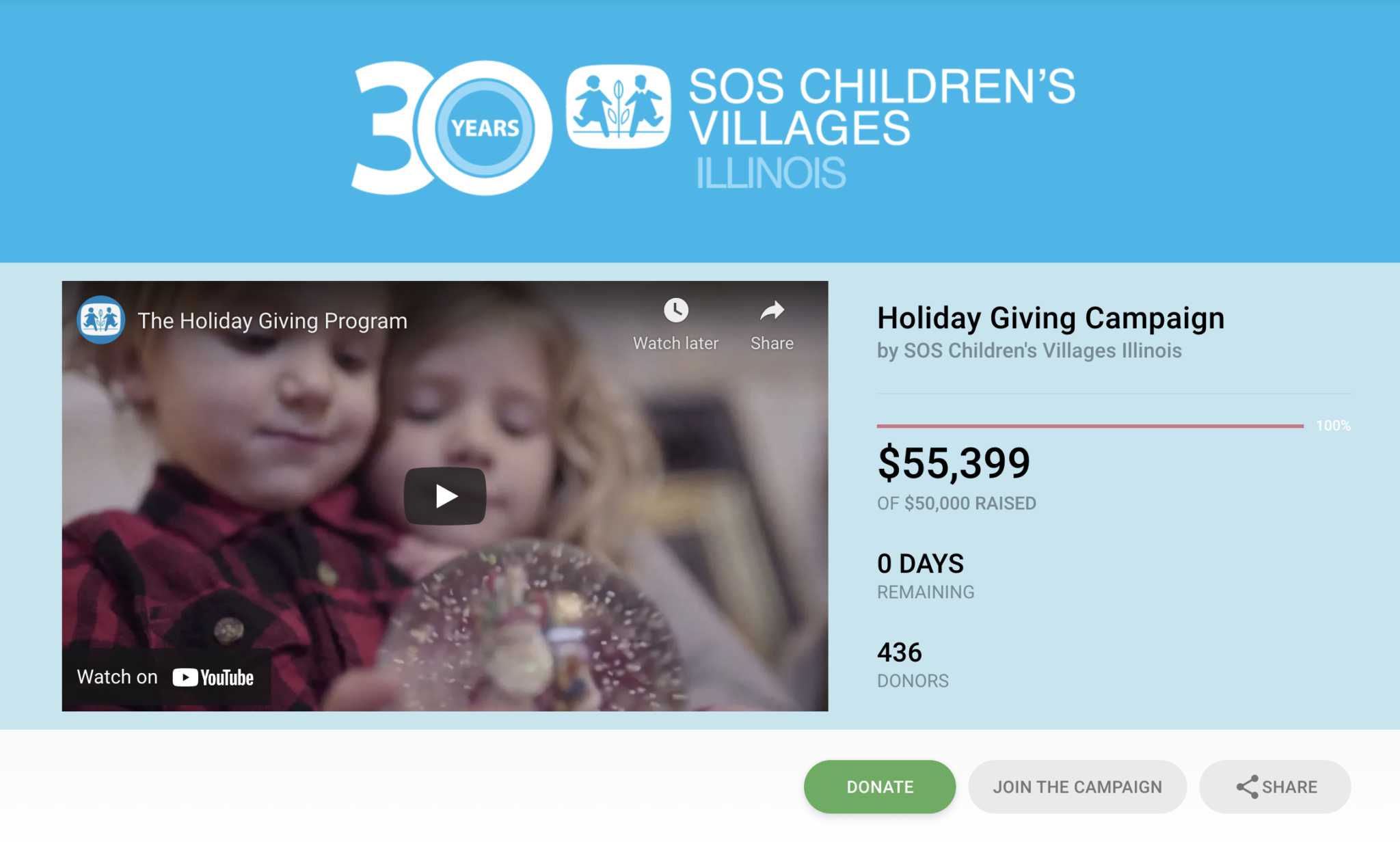
All donors give to the same umbrella theme and goal through a crowdfunding campaign. However, you may want to consider adding peer-to-peer fundraising onto your campaign so individuals may choose to set a personal fundraising goal to support the overall goal. No bells or whistles — just straightforward.
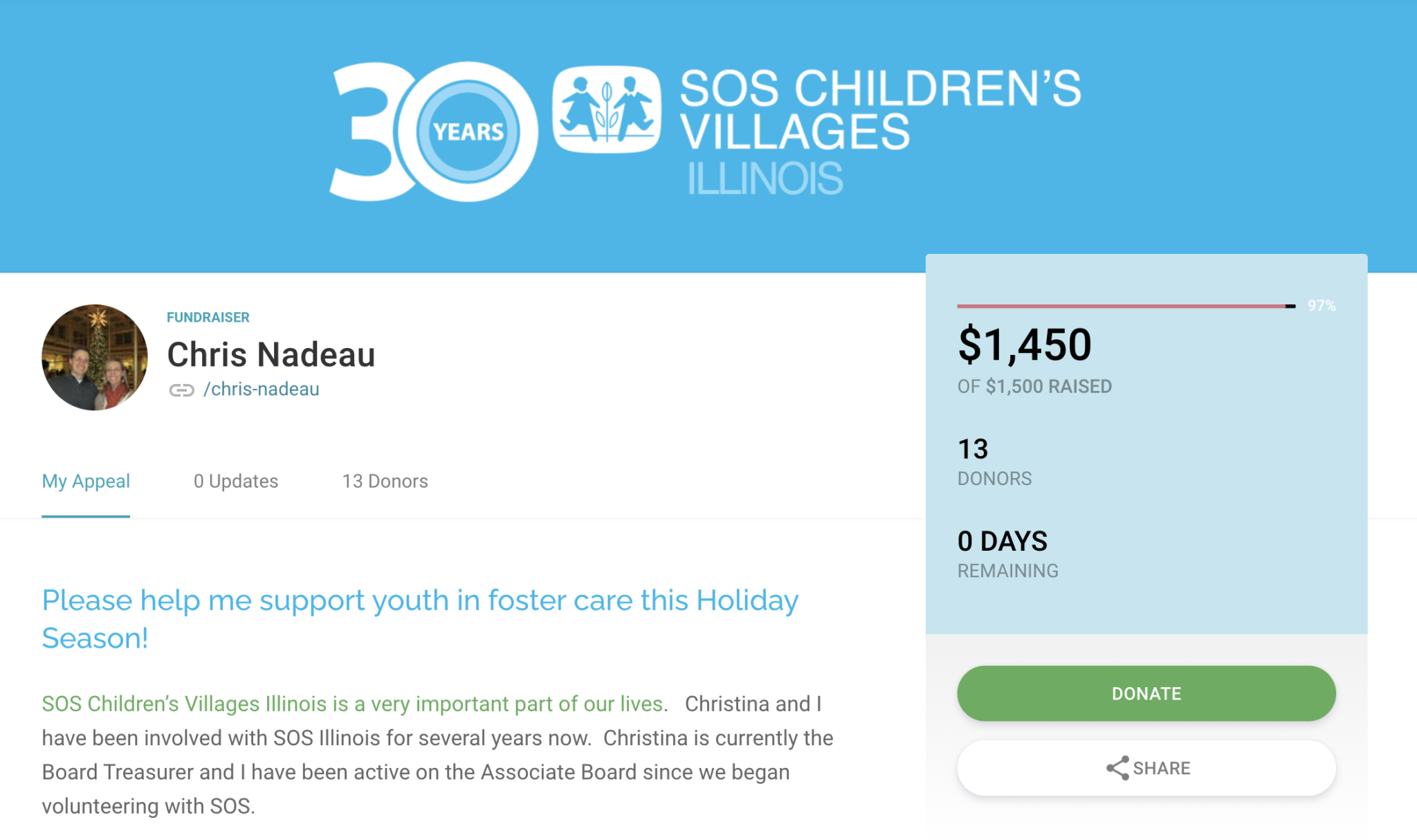
SOS Children’s Villages Illinois acquired 75% of their new donors for the entire year with their year-end peer-to-peer fundraising campaign.
2. Peer-to-Peer Fundraising:
This strategy leverages your donors’ personal networks, allowing them to develop their own campaigns, create teams, and share stories to support a larger theme.
For organizations whose mission impacts a large number of people in a more direct way (like education or health), this style of year-end fundraising campaign may work best.

One incredibly important piece of peer-to-peer fundraising is supporting your fundraisers. It’s a great idea to create a toolkit that your fundraisers can use to guide their work. Provide them with graphics, sample posts, press releases, email templates and more.
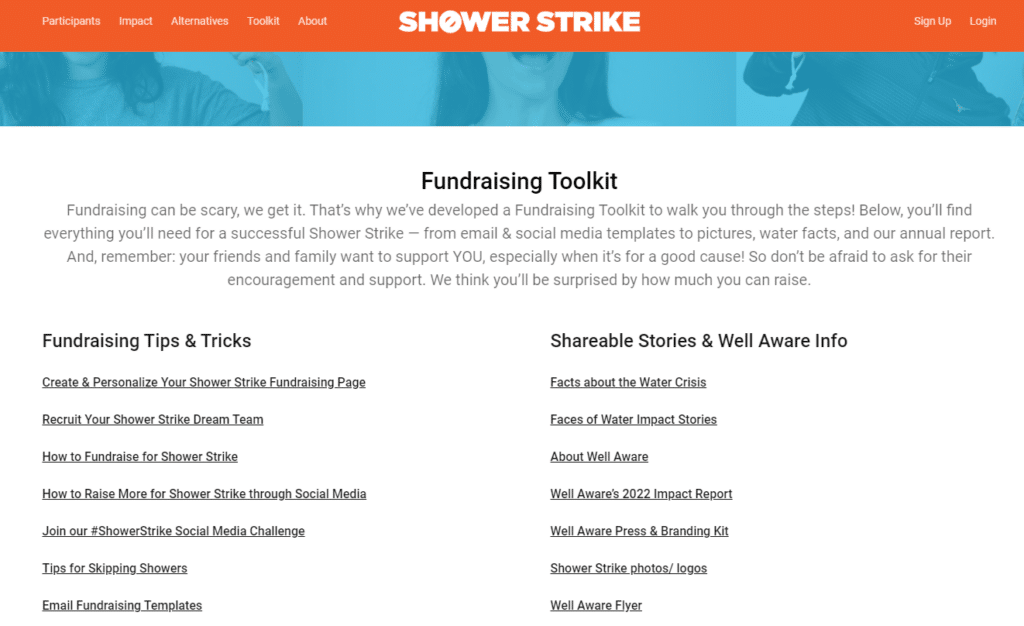
You can provide a peer-to-peer toolkit like this that has links to all your fundraisers could ever need!
3. Activity or Event:
An event can be a powerful way to raise funds for your campaign in real time. Hosting an activity, whether virtual or in-person, allows you to engage your audience and create a memorable experience that drives donations on the spot.
For example, something like the gratitude crawl Spur Local did—where participants visit local businesses or landmarks in a show of community support—can be an interactive and meaningful way to raise awareness and funds. The sense of shared experience helps build connection and excitement around your cause, encouraging people to give generously.

However, it’s important to consider the resources needed to pull off an event. Some activities may require more time, budget, and staff than others, so plan carefully to ensure your event complements your other year-end campaign activities without overextending your team.
By strategically planning an event or activity, you can create an opportunity to engage supporters and bring in significant contributions to help you reach your fundraising goals.
Developing A Year-End Campaign Strategy
When it comes to the year-end giving campaign, it’s time to haul out all your best practices and secret strategies, and go all in. Especially for organizations who have major fundraising goals they need to reach to continue operations and programs into the next year — it’s now or never!
To that end, there are multiple approaches to consider when developing your strategy, to ensure you’ve covered all the bases and you can get the most bang for your buck.
Here is a list of ways you can cover more ground for your year-end campaign:
Share Your Story
As we mentioned in the P2P section, your donors’ stories are an essential element to creating a connection to your cause and to reach more potential donors and new community members.
Your donors want to hear those stories. They want to know how you’ve stuck with them through thick and thin. You need to be able to illustrate your impact. This inspires donors to give, but also to become a part of the story, which is what keeps their commitment to your cause going, even after the campaign.
When coming up with a story for your campaign, consider what kinds of stories connect with your community the best and see what kinds of stories have worked best on social media.
Once you know what story you want to tell, consider the Pixar framework:
Once upon a time, there was ____________.
Every day, _____________.
Then one day, __________.
Because of that, _________.
Because of that, __________.
Until finally, ________________.
For more storytelling tips, check out our guide, The Complete Guide to Storytelling for Nonprofits.
Engaging Your Board in Year-End Fundraising
Reaching out to your board is another great avenue to boost your year-end fundraising activity. Engaging individual board members will help you to expand your potential reach by leveraging their personal and professional networks, and it could also provide you with some new content and stories.
To start, meet with your board members. Do this one-on-one or take advantage of a board retreat or annual meeting. Seek to understand what drew them to get involved with your organization and issue. Discuss your goals and brainstorm ways they can support you further.
Then, ask your board members to make connections. Board members, like any other donor or follower who believes in your work, will likely be happy to connect friends, family, and colleagues with your nonprofit and the work you do. A few introductions from these stakeholders can make a huge difference in your fundraising reach.
Finally, involve your board members in showing gratitude. A heartfelt ‘thank you’ to a donor who has contributed a large amount or helped extend your reach can go a long way and a ‘thank you’ from a board member can go even farther. Ask them to compose a quick, hand-written note or an email or see if they can make time for a phone call or even a lunch with top donors. This extra recognition can turn a one-time donor into a regular contributor.
Establishing Corporate Partnerships
Corporate partnerships are a great way to boost fundraising at any time of year but especially at year-end. By partnering with a corporation, you can not only increase your impact but also add incentive for your donors.
Partnerships come in all different sizes: they can be as simple as sharing your campaign on social media or as extensive as co-hosting a major event and making a big gift.
Many retailers and corporations are involved in nonprofit partnerships for GivingTuesday and actively give back during the year-end giving season. If you have a chance to partner with an organization that can bring extra credibility, reach bigger audiences, and help to make a bigger impact, then by all means, go for it.
Engaging your corporate partners in donation matching is a powerful way to boost donor engagement and maximize your fundraising efforts. With automated matching doubling the impact of donations is now as simple as a click. This feature recognizes corporate sponsors and optimizes match days, making the matching process seamless and effective.

For example, consider the impact of Tito’s 1:1 match—normally, a $20 donation would provide one person with clean water for life, but with the match, that same $20 helps two people. Automated matching not only accelerates fundraising efforts but also offers donors real-time insight into the amplified impact of their contributions.

Gone are the days of manual matching processes; automation has streamlined the experience, making it more satisfying and engaging for both donors and organizations.
If you haven’t secured a corporate partnership yet, here are some things to consider as you approach one.
1. Choose a partner that makes sense for you.
Not every corporation would make a good partner. The ideal partner for you will be an organization or company that aligns with your brand in some way—be it location, values, goals, or product.
2. Make it mutually beneficial.
Successful partnerships are those that benefit both parties. Think beyond the support they’ll provide to you—what can you offer them in return? Whether it’s promoting their products, highlighting their social responsibility efforts, or giving them visibility through your platforms, a mutually beneficial arrangement strengthens the partnership. Discuss ways to feature them on your website, in your emails, or across social media, showcasing their involvement and strengthening the relationship.
3. Manage and maintain the relationship.
Once you’ve established a partnership, it’s essential to nurture and maintain that relationship beyond just the year-end campaign. Stay in touch throughout the year, sharing results and keeping the lines of communication open. When developing a partnership agreement, consider creating a toolkit with all the promotional materials your partners might need, such as blog post and press release templates, logos, images, and approved quotes. Be specific in your expectations, like outlining a target number of social media posts or blog mentions, and track results from both sides.
4. Make the most of their brand
To make the most of your partners’ brand power, incorporate their names, social media handles, and logos into your campaign marketing wherever possible. This not only enhances your visibility but also adds credibility to your campaign. Additionally, encourage your partners to tap into their own networks by reaching out to their press contacts and engaging with their broader partner community.
Reach Out to Major Donors
A wide-reaching year-end campaign strategy is a great way to achieve fundraising success, but don’t discount the contributions of major donors, who are already familiar with your work and interested in contributing to your cause.
Here’s a few ways to get your big donors on board with your year-end campaign:
- Send them mail. Letters and brochures to major donors help get them all caught up on what they’ve accomplished with their help and showing them what they can yet still accomplish together.
- Appoint them as leaders. Peer-to-peer campaigns can often use a few team leaders-here’s where your major donors come in! They can set a great example and even help organize fundraisers.
- Ask to share their stories. Donors have more than just money to give. Set up a quick interview, ask them why they choose to donate so much to your organization, and share their story! It’ll encourage other donors and show them you see them as a hero for your cause, too.
- Call them. Or better yet, set up a meeting. Any way your nonprofit can establish a closer connection with your donors will show your major donors you care about them, and give you a space to explain more in detail your campaign.
- Host exclusive events. This not only makes your major donors feel valued but also gives them a chance to connect with each other and introduce friends to your cause, helping you attract new donors.
All Systems Go
Depending on your goals and your resources, you may use a little from all of these approaches for your year-end campaign.
Your year-end fundraising campaign should be a mix of what works for your organization, what will resonate with your community, and what will make the most impact for your goals.
Marketing & Communications For Year-End Giving
A huge element to a successful year-end giving campaign, like any other, is marketing and communications – but perhaps it’s even more important during this busy time of year.
As we mentioned before, between retail promotions and most nonprofits working towards end-of-year sales and donation goals, and people keeping busy during the holidays, it can be really tough to stand out with your message and mission.
But that doesn’t always mean that your marketing has to be totally unique and something new; it just means it has to be solid and strategic. Many organizations run the same year-end campaign again and again, some for decades.
Think Salvation Army and their Red Kettle campaign, or Oxfam International and their catalog of goats and other farm animals. These nonprofits have brand recognition and they have stayed true to their mission and to a campaign that works.
While we know that not all orgs have this same brand awareness, we believe that less can be more, that simple can be best. As always, you should craft a plan for your campaign that you know works for your audience, and tells your story as clearly as possible, however that may be.
To that end, there are some fundamentals to keep in mind when developing your marketing and communications strategy for each medium.
Website
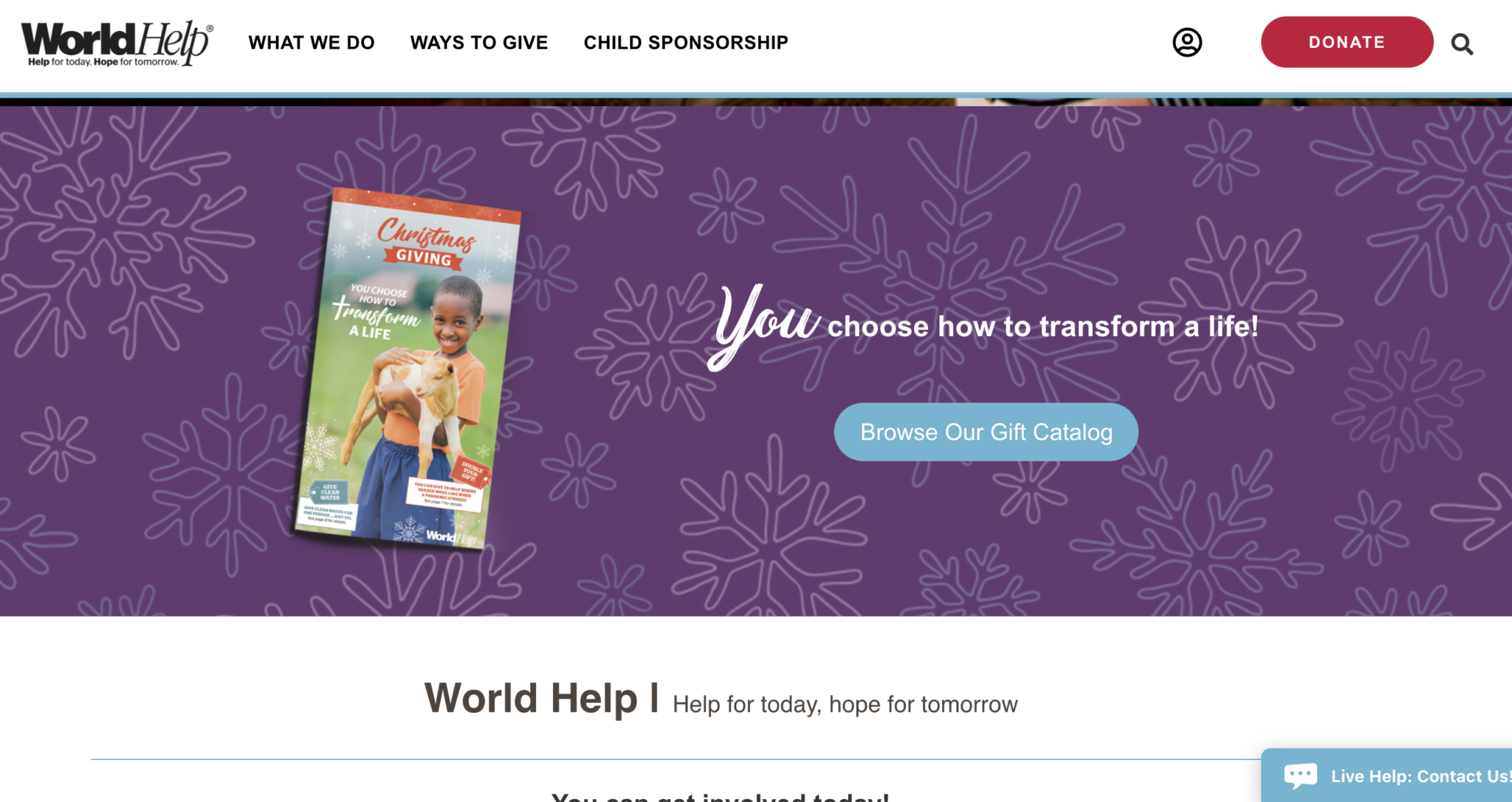
No matter what else you do, your organization’s website should clearly display your year-end fundraising campaign. There should be no question when someone visits your homepage that you have a campaign in progress, and within a few seconds, you should be able to determine the campaign theme, goal, and how to support it.
Even if you are sending visitors off to social media or a third-party fundraising site, it’s important that your website introduces potential donors to your campaign quickly and efficiently. Here are some ways to do so:
Homepage
- Create a featured banner with an image, graphic, and a short amount of text with the name of the campaign and the call to action. It should be above the fold and if you have a rotator/slider, make it the first one.
- Make sure the links to any campaign pages or relevant blog posts appear in homepage modules that feature content.
- Do you need a new navigation or menu item for this campaign?
Campaign Page

- You’ll want to create a dedicated campaign page. Think of this as the centerpiece of your fundraiser.
- The campaign page should clearly state the goal of the campaign, include powerful imagery,and include a donation button and links.
Content
- Is storytelling a big component of the campaign? Think of creating an embeddable photo gallery or a place to add videos, all of which can be easily viewed and shared.
- If your site has a blog or stories section, create at least one post relevant to the campaign.
Year-End Fundraising Email Campaign
For many nonprofits, especially small ones, email continues to be a main driver for action and fundraising.
Even if your campaign is heavy on social media, it’s still a good idea to include at least a couple of emails to your list for your year-end campaign – at a minimum, one to launch, one to provide an update and make a second ask, and one at the end.
In addition to reaching people who may not be following your organization on social media, email can be a great way to do deeper storytelling for your campaign, and give more details around the impact you’re hoping to make.
Try to be creative with your subject lines (see our 50+ suggestions for year-end email subject lines here) and think about the design and layout of your emails, too, to keep readers’ attention and boost your open and click rates.
One of the most powerful parts of online fundraising is segmentation. You can segment your emails based on the donor or engagement level, ranging from folks who have signed up for emails only all the way up to major donors. Within these segments, tailor content and the appropriate call-to-action to move them up to the next level.
You can also use this kind of segmentation to build onboarding emails with a particular theme and message throughout the season. This introduces new donors to the community and educates them about the issue and ways to get involved.
Here are some email options to consider for your year-end campaign:
Direct donation ask
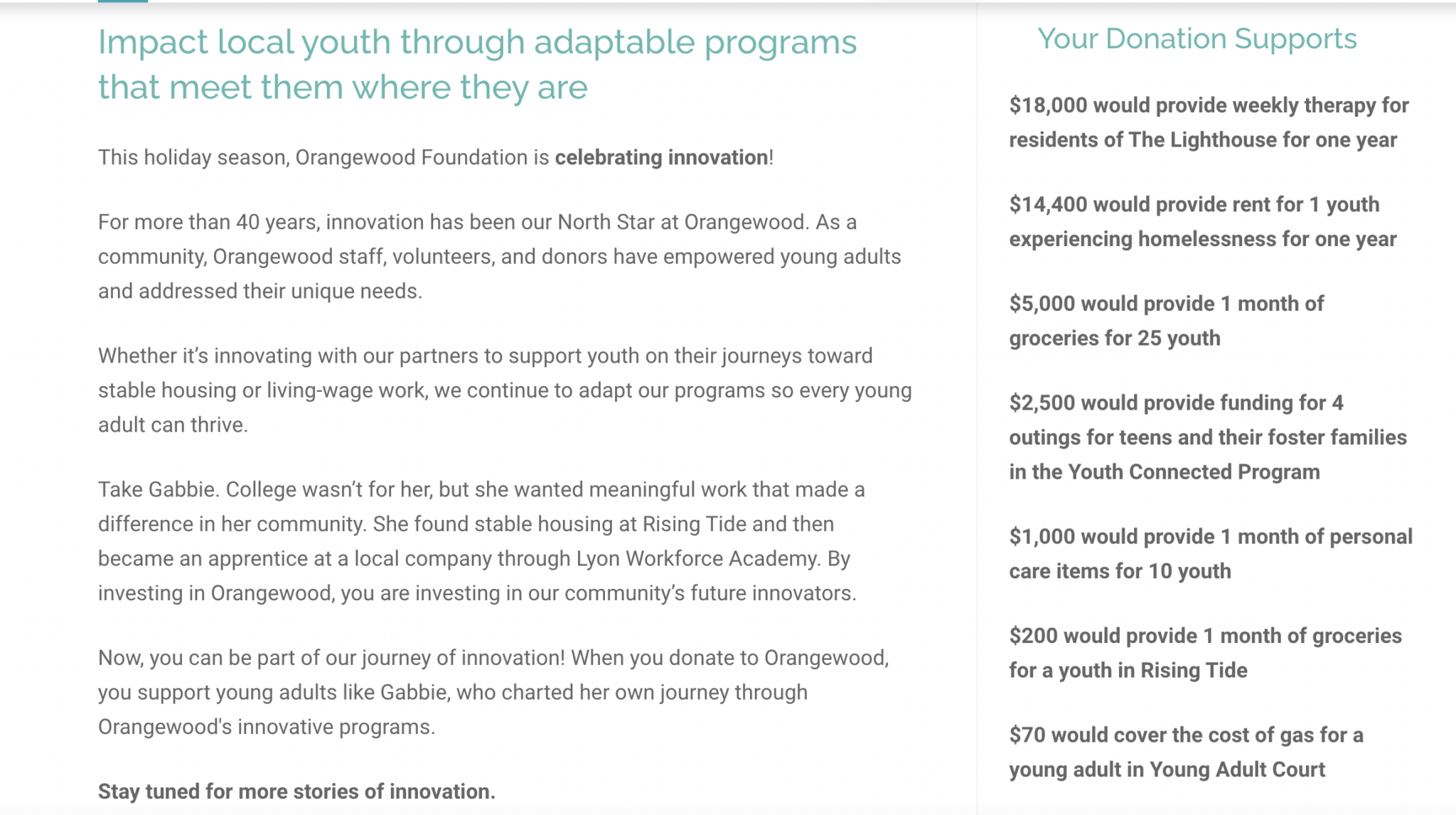
When making a direct donation ask, it’s important to be clear and straightforward. You’re raising money, so don’t hesitate to ask for it! Many organizations use a mix of “soft” and “hard” asks, blending storytelling with urgency. To boost engagement, consider providing a detailed breakdown of how each donation makes a difference—donors love transparency. As seen in our 2023 Giving Study, showing exactly where the money goes encourages giving. In addition, vary the senders of your emails by involving spokespeople and stakeholders, and make sure every ask includes a clearly visible donate button and multiple clickable links.
Storytelling
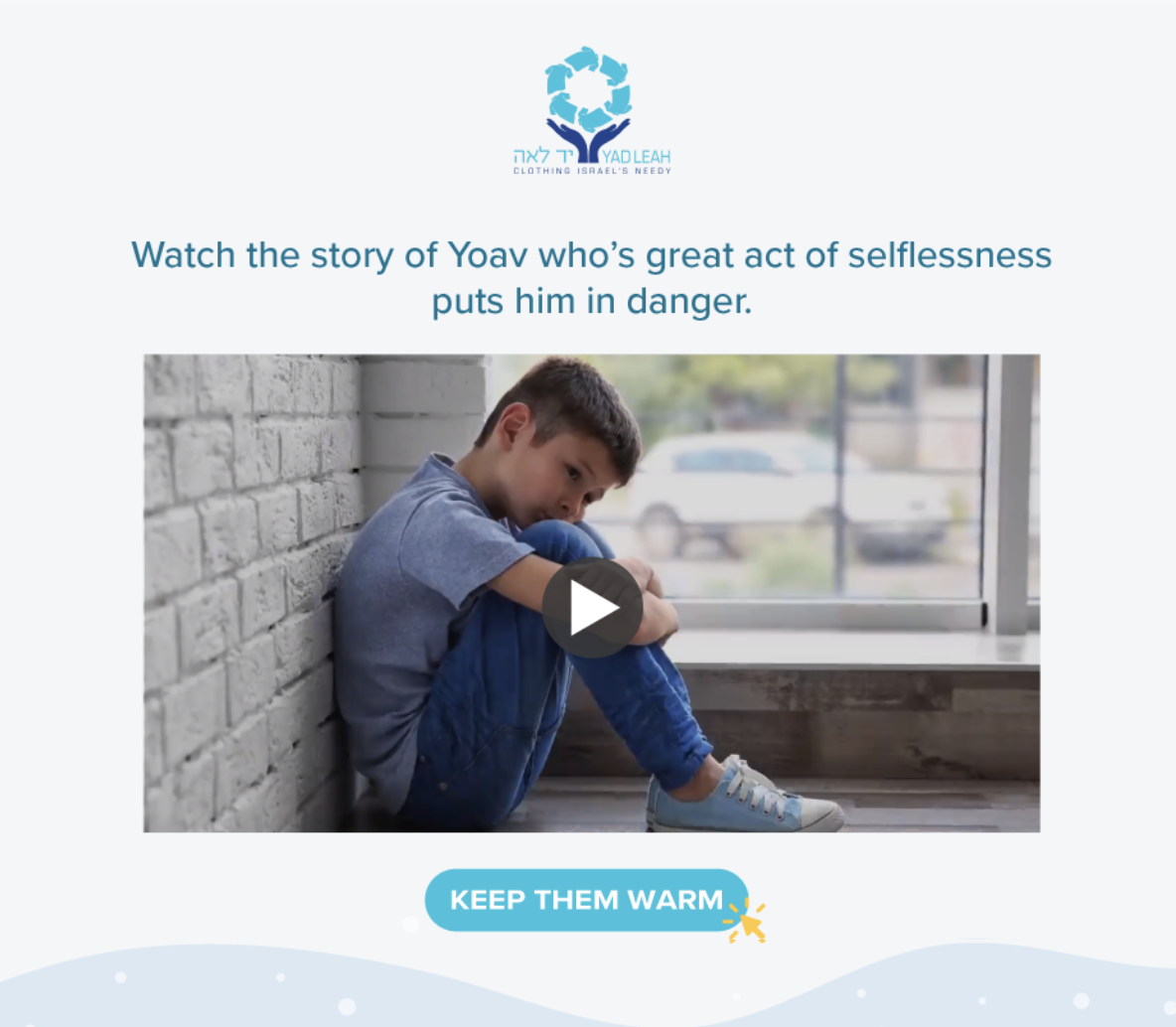
When crafting your storytelling, think about how your email content can guide readers to your website or another platform where they can continue engaging with the story or take action. Visuals are key—one powerful photo paired with concise copy can convey a strong message. Make sure your story clearly demonstrates impact and connects with donors on a personal level, ensuring they feel emotionally invested in your cause.
Thank you’s, updates, and miscellany
As your campaign progresses, it’s important to thank donors regularly to keep the momentum going. Share updates with hard data whenever possible to show the impact of their contributions and let them know what still needs to be done. Also, be prepared for any last-minute matching gifts, major announcements, or relevant news that could help drive even more engagement as you near the finish line.
Social Media For Year-End Fundraising
Social media is one of the most accessible and cost-effective ways to promote your year-end campaign. But it’s not enough to simply post on platforms like X (formerly Twitter) and Facebook and call it a day. It’s essential to have a well-thought-out plan and be strategic with your outreach and engagement across platforms like Instagram, TikTok, LinkedIn, and more—whether social media is a key part of your campaign or just a tool to help boost visibility.
Keep these best practices in mind for your year-end campaign:
1. Branding
When it comes to branding, consistency is key. Choosing a memorable and catchy hashtag or tagline that’s just 1-3 words long can help people easily recognize your campaign. For example, a hashtag like #FeedOurFuture or a tagline like “Power Up Learning” reinforces your mission, making it easy for people to remember, search, and engage with your campaign. Make sure it’s easy to type and sticks in people’s minds. Once you’ve decided on your phrase, use it across all your social media posts. This not only reinforces your message but also makes it easier for people to search for and engage with your campaign.
Before finalizing your hashtag or tagline, it’s a good idea to check if any other organizations or campaigns are already using something similar. If they are, it might be worth brainstorming a new one that feels unique to your campaign.
2. Match Content to the Appropriate Platform
When it comes to matching content to the right platform, it’s important to tailor your approach. If you have plenty of photos or videos, platforms like Instagram and Facebook should play a big role in your social media strategy. Visual content thrives there, so make it easy for supporters to share or repost your images and videos. For quick facts, stats, or direct donation appeals, platforms like X (formerly Twitter) are ideal since they’re great for bite-sized information and immediate calls to action.
One thing to keep in mind—don’t clutter Instagram captions with complicated URLs or create too many steps for people to take action. Simplicity is key. The easier you make it for people to engage, the more likely they are to participate.
3. Time it Just Right
Timing is just as crucial as the content itself. If your campaign spans more than a couple of days, it’s important to spread out your messaging over several weeks. Build a story arc that starts with educating your audience and building your brand awareness. Gradually, you can introduce personal stories or a “soft appeal,” where you mention the cause without directly asking for donations. As the campaign progresses, shift toward a “hard appeal” with clear, direct calls to action for donations.
To avoid social media fatigue, find additional ways for people to engage with your campaign beyond just donating. Encourage them to share your content, view stories, or even submit their own.
Take a look at some other social media tips that can work for a GivingTuesday campaign, or a year-end one, or both.
Public Relations And Outreach
Additionally, traditional media outreach can still be a great way to market your year-end campaign.
In fact, so many bloggers, reporters, and other media professionals use social media now to find news and break news that you should consider reaching out to them on your chosen social communities to share what your organization is doing.
Tools and resources like Help A Reporter Out and the Public Insights Network make it easier for journalists to get the stories they need. While you may not want or be able to develop a comprehensive public relations plan, we have a few options to include at a minimum to get you started.
1. Compile a Blogger List
It’s essential to keep an ongoing database of bloggers who write about causes similar to your organization’s mission or philanthropy in general. Start by identifying those who are influential in your space—whether they focus on nonprofit work, social impact, or specific issues related to your cause. Once you’ve compiled this list, break it down further into subcategories based on how their content aligns with your campaign’s specifics. For example, if your campaign focuses on hunger relief, you might have a sub-list of bloggers who focus on food justice, local community support, or health and wellness. Keeping these lists updated regularly will make it easier to quickly reach out and share relevant news about your campaign.
2. To Release or Not to Release?
While press releases aren’t as commonly used in today’s fast-paced digital media landscape, they can still be a valuable tool depending on your campaign’s goals. If you’re partnering with a high-profile organization or working on a project that ties into current news and events, a press release could help you gain extra media attention. Releases can also be useful if your campaign involves an important milestone or announcement that journalists or media outlets might want to cover. Even if you’re not sure about a full press release, you can consider pitching a media advisory or a short note to select journalists to let them know about your campaign’s relevance to trending topics.
3. Offer an Exclusive to One Outlet
If there’s a media outlet, blogger, or influencer you’ve been eager to collaborate with, offering them an exclusive angle on your campaign can be a smart strategy. This could be in the form of an interview with your CEO or an early scoop on a major campaign announcement. An exclusive can help build stronger relationships with influential voices in your industry, and having them onboard as a primary supporter or advocate can give your campaign credibility and visibility. It’s also a way to reach a more targeted audience through outlets or influencers that align with your message.
Whether or not you do any direct media outreach, it’s important to have a press or media kit ready for any outlet that wants to feature you. Prepare important campaign collateral like logos, graphics, photos, and more, and use an easy to access service like Dropbox or Google Drive for file uploads, viewing, and sharing.
4. Other (advertising, events, print, etc.)
There are many ways to boost your marketing and communications for year-end fundraising in 2024. If your budget allows, consider advertising on social media or through local channels, arranging interviews with stakeholders, or hosting a volunteer activity or fundraising meetup. While digital strategies dominate, direct mail can still be effective and help you stand out as fewer organizations use it. Be creative in reaching new donors and telling your story in a compelling way that drives donations. Keep in mind donor behavior, holiday schedules, and what resonates most during the year-end season.
Getting Started
So here we are. So much to do, and so little time! If you haven’t gotten started on your year-end campaign yet, let’s get to it. At CauseVox, we’re ready to get you up and going on a custom-made, easy-to-use fundraising website in just minutes.
And this guide is just the beginning of all of the resources out there to help you create and execute a successful year-end giving campaign, starting today.




